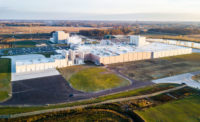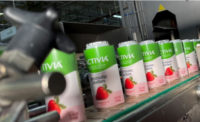Dairy plants seek sustainability solutions
Dairy processors have a plethora of options to green up their operations.

image courtesy of zhongguo via gettyimages.com.

DuPont Water Solutions’ FilmTec Hypershell membrane elements save water and energy. Photo courtesy of DuPont Water Solutions

Dairy processors should focus on wastewater treatment as a way to green up their operations. Photo courtesy of Kurita America

Schoeller Allibert’s bulk containers can help reduce packaging waste. Photo courtesy of the Schoeller Allibert U.S.




A company’s environmental sustainability story — or lack thereof — is increasingly influencing consumer purchasing habits. In fact, a recent survey from IBM Institute for Business Value found that 54% of consumers “are willing to pay a premium for brands that are sustainable and/or environmentally responsible.”
And “greening” up plant operations is one important way for dairy companies to address consumer concern about environmental sustainability. However, there isn’t just one golden ticket solution that will reduce a plant’s environmental footprint.
“All environmental aspects should be considered,” says Yolanda Cuenca, technical expert, dairy at DuPont Water Solutions, Edina, Minn.
Dairy plants should look into reducing carbon dioxide emissions, water usage, total waste (including operational waste and food waste) and the amount of packaging used to make their operations more sustainable, she explains.
Glenn J. Emory, general manager – North America for Reading, Pa.-based Weidenhammer Systems Corp., says he’s noticed that many dairy companies are making steps in the right direction in terms of environmental sustainability.
“I applaud the dairy industry as being at the forefront of alignment between industry deliverables and consumer expectation,” he adds.
Focus on water
To make a plant more environmentally sustainable, processors need to consider how natural resources are used and possibly reused in their facility, notes Cuenca.
And water often is “the most concerning utility for sustainability efforts,” Joe Weisgerber, manager, environmental health and safety for Cincinnati-based Hixson Architecture & Engineering, points out.
“Dairy plants are considered wet plants due to the high volume of water used in the process for cleaning, diluting and rehydrating,” Cuenca notes. “This is especially critical considering the expansion of dairy plants in dry regions, where every drop is more and more precious.”
Scott Fisher, corporate account manager, and Brett Robison, director – strategic corporate business for Minneapolis-based Kurita America, concur that water is an issue in most dairy plants.
“Most plants struggle with water,” they say. “Either the facility has too much of it — generating water from cheese and whey processing — or the facility is limited on how much potable water is available for use.”
Laura Black, global product manager – process and specialty spirals for Ludwigsburg, Germany-based Mann+Hummel Water & Fluid Solutions (formerly known as Microdyn-Nadir), says demand for water-efficient technologies is particularly high in water-scarce regions such as California, where regulations are adding to sustainability challenges.
And to make water usage more sustainable, dairy plants need to have a holistic approach. Processors should “consider all the processes where water is used and make a list of the water consumption,” Cuenca notes. “Re-considering every process, being prepared to make process change[s] and being willing to invest can really help with water recovery and reuse as well as energy costs,” she adds.
However, before coming up with a plan to reuse/recycle water, dairy processors should evaluate their “water balance and typical effluent quality,” note Fisher and Robison. They also should make sure they have a full grasp of the Pasteurized Milk Ordinance.
“There are direct guidelines laid out in the Pasteurized Milk Ordinance, and understanding your facility operations, quality of water generated and facility risk tolerance will help guide the direction and technology choices to better reuse this water,” they explain.
Warren Green, vice president and manager, process engineering for Hixson, points out several ways in which processors could improve their water usage.
“We suggest dairy processors consider the following: Develop a goal based upon their current water use ratio; collect metering data and install meters in strategic locations to monitor water usage; develop cost metrics for various value-added waters generated and used; seek out and document water wasters, reduction opportunities and water alternatives; evaluate project economics; and implement a program of SOP changes, maintenance and capital improvements,” he explains.
According to Alberto Picon, who works in dairy sales at Holland, Mich.-based Fogg Filler, processors should opt for clean-in-place skid systems “that will optimize the use of water by reusing some of the rinsing water as a pre-rinse or as a solution preparation” as a way to reduce consumption.
For its part, DuPont offers solutions to water sustainability challenges and enables “energy-efficient purification and concentration steps,” Cuenca points out.
“Reverse osmosis polisher systems downstream [are] an obvious way to recover good quality water or to purify water for strict discharge limits,” she says. “Using specific cleaning chemicals and protocols [may] reduce the cleaning time and water wasted ... FilmTec Hypershell membrane elements perform better in this case than mesh wrap ones in terms of saving energy and water.”
And Mann+Hummel offers TurboClean sanitary elements that can help processors reduce water usage, notes Black.
“In an average whey processing plant, savings of nearly $13,000 per stage were recorded in energy savings,” she says. “In a rinse following operation on 18% skim milk, TurboClean elements were shown to rinse with up to 35% less water.”
Consider wastewater treatment
Addressing wastewater issues could be the single biggest way to green up a plant, notes Weisgerber. If feasible, plants could take “big step towards internal sustainability” by investing in wastewater treatment technology that allows for water recycling and reuse.
“If you want to reach a mass-based sustainability goal, go after one of your heaviest wastes: wastewater,” he says. “Producing 100,000 gallons/day of wastewater equates to 417 tons per day.”
Cuenca explains that many plant processes need to be considered when evaluating wastewater.
“Cleaning and flushing of tanks, pipes and membrane systems, in general, are a big contributor of wastewater,” she adds. “[Reverse osmosis/nanofiltration] permeate, evaporator condensate and dryers can also be significant contributors of wastewater.”
Finding ways to “process and reuse” wastewater so that less is sent to a treatment plant also can help reduce water usage in plants, Cuenca notes.
Fisher and Robison say many plants “are antiquated and likely hydraulically overloaded,” as they have expanded the volume of their operations over time.
“Simply replacing a [dissolved air flotation system], for example, may not be the best move if regulations and flow volume are high,” they add. “A thorough review of other technologies such as biological oxygen demand automation, biological systems and sludge presses may prove to be good investments.”
Waste not
Reducing waste also is crucial to making a dairy plant more environmentally sustainable. However, every dairy product has its own waste stream, “which is then treated in a unique manner like milk, cheese, whey, butter and so on,” Cuenca points out, adding “that means there are many ways in which improvements can be made.”
Processors should look for any local operations that have anaerobic digesters that could use off-spec product for gas (methane) generation, notes Weisgerber.
“Digesters are more likely at large facilities — e.g., 10,000-plus-head dairy farms or other concentrated animal feeding operations,” he says. “However, don’t limit your search to just nearby dairy farms: Poultry and swine businesses also use digesters. You could also consider installing your own.”
When looking at reducing waste, “don’t forget recycling,” Green points out, noting that several of Hixson’s clients now run “zero landfill” facilities.
“Landfill waste reductions are possible with a dedicated recycling program to ensure that any and all recycling wastes are properly segregated and outsourced and/or sold to customers for re-purposing,” he explains.
However, one challenge dairy plants face is that they often produce high-strength waste that can be difficult to dispose of and which cannot be recycled.
“In many parts of the country, phosphorous limits are becoming more stringent, which is challenging as dairy processes generate high amounts of phosphorous as a milk derivative,” Fisher and Robison say. “And most plants also are challenged with fats, oils and greases and biological oxygen demand, requiring some level of processing to remove these contaminants.”
Packaging is another area where plants could reduce waste, says Pat A. Cici Jr., marketing manager/Western Region sales for Schoeller Allibert U.S., Goodyear, Ariz.
“From the bulk packaging perspective, dairy processors, much like all food and beverage processors, should look at their current bulk containers and determine how, and how often, they are being used throughout their supply chain,” he explains, “especially if they ship their product in bulk as raw ingredients to their clients rather than using the containers solely in-house.”
For its part, Schoeller Allibert offers the “Combo Excelsior Hybrid 265 gallon foldable, reusable bulk container, which was designed specifically for liquid food and beverage products such as many different types of dairy products,” Cici says.
This container eliminates some single-use packaging, which can help reduce waste, Cici adds, as well as save processors money and reduce water and energy needed to wash one-way containers before selling them into the container market.
“Our reusable bulk containers use a ‘bag in box’ system: The product is filled into a liner bag inside of the container, not into the container itself,” he notes. “So when the end user empties the product from the liner bag inside of the container, they remove and recycle the liner bag and then return the container back to the processor — oftentimes with little to no washing required — unlike the required processes to clean one-way containers.”
And Weidenhammer launched a freezer-grade, post-consumer recycled plastic pallet program. The pallet “eliminates downstream pallet demand,” is “designed for high-count reusability and can be fully recycled,” and is “more hygienic than wood pallets,” Emory notes.
“It is the right sustainable step to take,” he says.
Be more efficient
It’s also important for processors to evaluate their energy usage if they want to make their plant more sustainable, notes Green. Hixson has observed the largest energy users in dairy plants to be heating and cooling for thermal processing, supplying power to processing/packaging equipment and refrigeration.
“Steam boilers and driers use the most natural gas in dairy plants,” Fisher and Robison say. “And chillers, ammonia compressors, pumps and separators consume the most electrical energy.”
Certain processing methods are more energy-efficient than others, too, Picon points out. For example, ultra-high-temperature processing is less environmentally friendly than high-temperature/short-time methods.
Replacing or updating equipment is one way that dairy plants could become more energy-efficient. Dairy manufacturers should make a list of their processing equipment “such as plate heat exchangers, pumps, valves, homogenizers, separators, dryers” and evaluate the amount of energy they consume, says Cuenca.
“Now consider the big energy-consumers and consider what can be done to reduce energy consumption,” she adds. “Reducing the energy intensity of operations is a major target and commitment for dairy processors.”
Hixson recommends heat recovery as a way to increase energy efficiency in dairy plants. For example, processors could capture “waste heat from compressors” and then use that “to preheat cleaning water,” Green notes.
“Processors can also install utility system controls to efficiently sequence equipment operation and implement energy-efficient designs such as direct-fired water heaters, stack economizers on boilers and variable-frequency drives on fans, pumps and compressors,” he continues.
Another way to reduce fuel consumption and emissions output is to move from a traditional boiler system to a modular steam boiler, says Andrew Eklind, marketing manager for Miura America Co. Ltd., Rockmart, Ga.
“The main contributing factor is that modular boilers are meant to be placed in standby — pretty much off, but still using minimal power to keep online and aware — which reduces fuel consumption when you don’t need steam, and reduces the amount of emissions output versus traditional systems that have to keep the boiler warm in an idle state,” he adds.
Looking for a reprint of this article?
From high-res PDFs to custom plaques, order your copy today!











